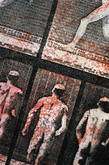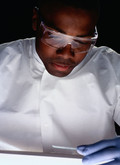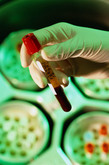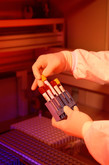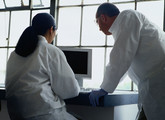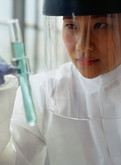Biosimilars/Research
New method for producing human-like glycosylated MAbs
As reported online on 28 February 2010 in Nature Chemical Biology, Professor Lai-Xi Wang, Professor Markus Aebi and colleagues describe a new bacterial method for producing homogeneous eukaryotic N-glycoproteins.
Glycosylation technologies for biosimilars and ‘biobetters’
According to Mr Hans Baumeister and Mr Steffen Goletz of Glycotope, human cell lines providing a human glycosylation pattern – such as those of Crucell (PER.C6), Cevec (CAP) and Glycotope (GlycoExpress) – have attracted increasing amounts of attention over the past years. In the case of biosimilars, regulatory approval now requires an extensive programme of bioequivalence studies to be undertaken to characterise the product in terms of its biochemical properties, safety and activity. As a consequence, glycosylated biosimilars need to be equipped with a similar pattern of glycosylation. For example, the degree of sialylation should not deviate by more than 20% from that of the original product. Hence, the chosen cell clone with high productivity has to be able to provide post-translational modifications as closely related to the originator’s cell line as possible. However, since glycosylation differs within clones, during the bioequivalence study it is often realised that the product carries different carbohydrates, usually resulting in a hyposialylation; this requires the screening process to be repeated in order to identify a new cell clone that is able to provide the equivalent glycosylation. Several glycosylation analysis technologies are available for the development and production of glycosylated biotherapeutics, applicable to both biosimilars and second-generation ‘biobetters’ (see Table 1).
Will the EU biosimilars pathway be applicable to monoclonal antibodies?
To what extent is the existing framework for biosimilars in Europe likely to be applicable to monoclonal antibodies (mAbs)? This question was verified in a paper by Dr Christian Schneider –member of the EMA’s Committee for Medicinal products for Human Use (CHMP), Chairman of EMA’s Biological Medicines Working Party (BMWP) and the Paul-Ehrlich-Institut in Langen, Germany– and Dr Ulrich Kalinke of the Paul-Ehrlich-Institut and Twincore Center for Experimental and Clinical Infection Research in Hannover, Germany, as published in Nature Biotechnology of September 2008.
A follow-on biologic drug is not a ‘biogeneric’: Lessons from Omnitrope and Valtropin
In an article by Dr Robert Roth and Dr Nicholas Fleischer of the Weinberg Group published in Journal of Generic Medicines of May 2009, it is stated that a follow-on biologic drug is not a ‘biogeneric’, based on lessons from Sandoz’s biosimilar human growth hormone Omnitrope (somatropin) and BioPartners’ Valtropin (somatropin).
PhRMA, Amgen correct NEJM article on biologics exclusivity
In a NEJM Letter to the Editor of 18 February 2010, Mr David Wheadon, Senior Vice President of the Scientific & Regulatory Affairs team of the Pharmaceutical Research and Manufacturers of America (PhRMA) –having been employed by several pharmaceutical companies (Eli Lilly, GlaxoSmithKline, Abbott) and holding stock in Abbott Laboratories and GlaxoSmithKline– corrects the NEJM Perspective article by Mr Engelberg et al. of 12 November 2009, writing that “the record should be set straight” with regard to the market exclusivity of biologicals in the biosimilars debate.
Improving effector functions of MAbs for cancer treatment: Enhancing antibody-dependent cell-mediated cytotoxicity (ADCC) and complement-dependent cytotoxicity (CDC)
Mr Akito Natsume et al. of Kyowa Hakko Kirin, Machida-shi, Tokyo, Japan, have shown to improve effector functions of monoclonal antibodies (MAbs) for cancer treatment by enhancing ADCC and CDC, as published in their review article in Drug Design, Development and Therapy 2009:3 of December 2008.
Abbott: Non-responding RA patients with anti-infliximab antibodies may switch to less immunogenic anti-TNF
In the race for biosimilar/biobetter monoclonal antibodies (MAbs), it is interesting to compare originator MAbs, e.g. mouse-human chimeric infliximab (Remicade) of Johnson & Johnson’s Centocor versus Abbott’s fully human – and thus less immunogenic – adalimumab (HUMIRA).
ADCC enhancement technologies for monoclonal antibodies
In a 2009 article by Dr Cheng Liu, founder and CEO of Eureka Therapeutics in California, and Andreia Lee in Trends in Bio/Pharmaceutical Industry on Antibody Therapeutics, it is stated that ADCC (Antibody Dependent Cell-mediated Cytotoxicity) enhancement is a key strategy for improving therapeutic antibody drug efficacy against cell-surface targets in cancer and chronic inflammation. It takes advantage of patients’ innate immune cells to kill target cells. The functions are primarily triggered through direct interaction of the Fc domain of human immunoglobulin (in most cases IgG1) with the corresponding receptors. Therapeutic antibodies with enhanced ADCC are anticipated to have a clinical advantage owing to increased specific lysis of target cells, such as cancer cells, mediated by Fc receptors present on natural killer cells, macrophages, and other immune cell types.
Xencor: Via Fc engineering enhanced antibody half-life improves in vivo activity
Improved affinity for the neonatal Fc receptor (FcRn) is known to extend antibody half-life in vivo. However, this has never been linked with enhanced therapeutic efficacy. Mr Jonathan Zalevsky and Dr John Desjarlais et al. of Xencor at Monrovia, CA, USA, studied if such enhanced antibody half-life improves in vivo activity, as published online in Nature Biotechnology on 17 January 2010.
Ustekinumab better than etanercept in psoriasis trial
In a study by Christopher Griffiths et al. of the University of Manchester, UK, Johnson & Johnson (J&J)’s monoclonal antibody STELARA (ustekinumab, an interleukin-12 and interleukin-23 blocker) and Amgen’s Enbrel (etanercept, an inhibitor of tumour necrosis factor: anti-TNF) have been compared for the treatment of psoriasis, as published in The New England Journal of Medicine (NEJM) of 14 January 2010. The Phase 3, Multicenter, Randomized Study Comparing CNTO 1275 and Etanercept for the Treatment of Moderate to Severe Plaque Psoriasis’ was sponsored by J&J’s Centocor.
